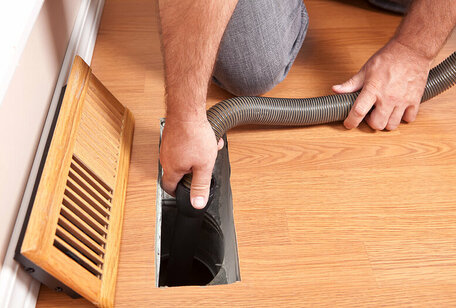|
Air duct cleaning is a relatively straightforward process: the combination of a vacuum and agitation tools or air pressure is used to clean debris from inside your HVAC ductwork. For savvy and motivated homeowners who are determined to do things themselves, air duct cleaning is also in their sights. Here are some things you can do yourself to help maintain the cleanliness of your air ducts. Clean vents and registers
A fair amount of the debris found in your air ducts is located in the area just behind your registers, especially those in the floor. To clean this debris, remove the register and insert a vacuum hose as far as you can reach, sweeping from side to side to collect as much as possible. You'll likely hear debris as it moves through the hose, an indication that the effort was successful. Some DIY sites suggest the insertion of a brush of some kind, even a dryer vent cleaning brush, to loosen debris stuck to the sides. Do this if you feel the need, though it's unlikely to add much to what you collect. The registers themselves are usually easily lifted from the floor or unscrewed from the wall. Once removed, they can be wiped down with a cloth dampened with multi-purpose cleaner or mild detergent. Allow to dry before replacing. Regularly change your air filter This is the single-most important thing you can do in order to keep your air ducts (and furnace) clean. An air filter—or furnace filter--prevents dirt and debris from entering your furnace and clogging up its parts, and further from being deposited in your ducts and recirculated to the rest of your home. In short, most dirt stops at the filter. Keep in mind that a cheap filter will likely allow too many particles through, while the most expensive and effective option may block particles so small they hinder air flow. Best practice would be to opt for something in between the two extremes. But based on how inexpensive filters cost and how easy they are to replace, there's little excuse for not changing them regularly. Vacuum your furnace The motivated homeowner may want to take things a step further and vacuum their furnace's combustion chamber. After ensuring the power to the furnace is off, remove the panel to the combustion chamber. Use your vacuum's attachment tool to carefully suck up any dust and debris from around the various parts. Be careful not to jostle any wires or delicate parts in the process. This measure can be followed up with a wipe-down from a slightly damp cloth to finish. Where the pros come in The above steps can help to reduce the amount of dirt and debris in your duct system but are limited in their reach. Your home's ductwork, because of its vastness and necessarily complex layout, will have many areas that are simply inaccessible with laymen's tools. Professional duct cleaners, with their gas-powered vacuums and flexible air whips designed to easily snake around inside duct systems and thrash debris loose, are equipped to tackle the various challenges presented by diverse configurations and labyrinthine HVAC systems. Further, there are myriad cases when levels of dust and debris are such that the most thorough cleaning available is called for, and no DIY attempts are going to cut it. These cases include the following:
Wanna dig deeper? Download our free tipsheet: 10 Questions to Ask Before Hiring an Air Duct Cleaning Company. Download Tipsheet Many thanks to our technician Zach C for lending his expertise to this article.
0 Comments
|
SearchArchives
April 2022
|
Twin Cities Furnace Cleaning - Open 7 Days a Week 8AM to 8PM

